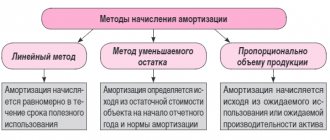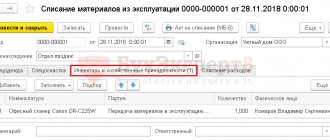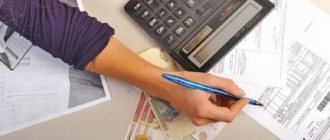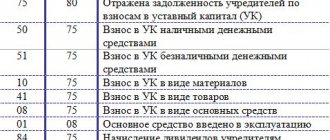How to organize accounting of workwear
Institutions are required to provide their employees with personal protective equipment when performing work functions.
This is evidenced by the Order of the Ministry of Health and Social Development of Russia dated 01.06.09 No. 290n. What kind of special clothing a given employee needs is determined based on the results of workplace certification. Certification also determines how protective equipment should be certified to perform a specific job. For simplicity, the term “working clothing” combines the concepts of “special clothing”, “special footwear” and “personal protective equipment”. The cost and shelf life of workwear items may be different, but in any case they are considered soft inventory, for which accounts of the type 0 105X5 000 are intended (Instruction No. 157n “On approval of a unified chart of accounts...”):
- 0 10525 000 “Soft inventory - especially valuable movable property of an institution”;
- 0 10535 000 “Soft inventory - other movable property of the institution.”
Inventory of budget off-balance sheet accounts
In accounting, the use of off-balance sheet accounts is mandatory. Institutions are required to conduct an inventory of all their property and liabilities to generate reliable information about their financial position. The assets, liabilities and assets listed on the organization's balance sheet are inventoried in the same way and within the same time frame as those on the balance sheet.
For more information on whether it is necessary to take an inventory of property located off-balance sheet, see the article “Is inventory required for off-balance sheet accounts?”
Arrival of workwear
Workwear is registered with the institution at its actual cost. What does this cost consist of? The basis, of course, is the cost of the clothing itself. To this are added additional costs for delivery, payment for intermediaries, duties, and other possible expenses that arose during the purchase and preparation for use. The accountant first collects all these amounts in account 0 10600 000 “Investments in non-financial assets”. Only after this can the workwear be accepted for registration.
Please note: you cannot change the actual cost of workwear after it has been registered (clause 107 of Instruction No. 157n).
If there were no additional costs, then the workwear is credited directly to the account 0 105X5 000. Let's look at this option using an example.
Example 1.
State Budgetary Educational Institution “Technical School of Mechanical Engineering”, using subsidies for the implementation of state assignments, purchased 10 sets of workwear for teachers of technical disciplines from LLC “Sila”. Total cost - 59,000 rubles, including VAT - 9,000 rubles. The institution also transferred 2,360 rubles (excluding VAT) to the transport company as payment for delivery. Let's assume that the purchased workwear is not particularly valuable property.
The GBOU accountant must generate the following entries:
| Contents of operation | Debit | Credit | Amount, rub. |
| The purchase price of the kits and the debt to Sila LLC are reflected | 4 10634 340 | 4 30234 730 | 59 000 |
| Money was transferred to Sila LLC | 4 30234 830 | 4 20111 610 | 59 000 |
| Transport costs and debt to Mig LLC are reflected | 4 10634 340 | 4 30222 730 | 2 360 |
| The debt to Mig LLC was repaid | 4 30222 830 | 4 20111 610 | 2 360 |
| The actual cost of workwear has been generated | 4 10535 340 | 4 10634 340 | 61 360 |
Let us note that different types of institutions have their own nuances of accounting for workwear. For example, government institutions receive it as part of centralized supply. The transfer is documented by means of a notice (f. 0504805).
Postings depend on the budget level and status of the institution:
| Contents of operation | Debit | Credit |
| The overalls came from other subordinate institutions within the department | 0 10535 340 | 0 30404 340 |
| The overalls were received from institutions that are under the control of different managers of the same budget level, or subordinate to the same GRBS as part of income-generating activities (similar postings will be made when receiving clothing from individuals). | 0 10535 340 | 0 40110 180 |
| The overalls were received from a budgetary institution of a different budget level | 0 10535 340 | 0 40110 151 |
Having received the protective clothing, the institution is obliged to mark it. The procedure is controlled by managers and accountants. The procedure for marking soft equipment is described in detail in paragraph 118 of Instruction No. 157n.
Key purpose
In accordance with Order of the Ministry of Finance No. 94n, off-balance sheet accounts are intended to account for various types of property assets and financial liabilities. Unlike the main accounting accounts, entries in sub-accounts are kept in a simplified manner, that is, bypassing the double entry method. In other words, the transaction is reflected either as a debit or as a credit to the corresponding auxiliary sub-account.
How many off-balance sheet accounts have there been since 2015? There are only eleven such subaccounts; let’s consider the key purpose of each of them.
Leased fixed assets
Fixed assets received under lease agreements are reflected at the cost specified in the contractual terms. If the lease agreement does not contain such information, and the lessor does not provide data on the value of the object, then fixed assets are taken into account at market value.
Office received for rent: Dt 001.
The machine was returned to the lessor upon expiration of the contract: Kt 001.
Inventory accepted for safekeeping
Material assets, raw materials and inventories received from third-party organizations, individuals or individual entrepreneurs should be reflected on the account. 002. Also, these off-balance sheet accounts are needed to reflect information about inventory items, for which ownership transfers only after full payment. Such conditions are fixed in the agreement or supply contracts.
Construction materials were received for safekeeping: Dt 002.
How to write off materials from an off-balance sheet account? The goods and materials were returned to the supplier: Kt 002.
MPZ accepted for processing (custom raw materials)
Materials and raw materials received from third parties without appropriate payment, intended for further industrial processing and return to the supplier company, are reflected in the account. 003.
Received customer-supplied raw materials: Dt 003.
Goods accepted for commission
Products that are accepted under commission agreements must be reflected on the account. 004. The cost of goods is determined on the basis of acceptance certificates.
Inventory and materials were received under a commission agreement: Dt 004.
Equipment accepted for installation
Information about the movement of equipment that the customer transferred to the contractor for installation and/or installation work is reflected on the account. 005. Accounting is carried out in the context of equipment items, at the prices specified by the customer in the transfer documents.
The customer handed over the air conditioner for installation: Dt 005.
Strict reporting forms
Accounting forms, blanks and other documentation that are classified as BSO are subject to reflection on the balance sheet. BSO includes: cash receipts, receipts, forms of diplomas, work books, certificates, postal products, etc.
Diploma forms written off: Kt 006.
Debt of insolvent debtors written off at a loss
Accounts receivable, which are registered with insolvent debtors, are reflected on the balance sheet for 5 years from the date of write-off of the receivable.
Receivables from insolvent counterparties are reflected on the balance sheet: Dt 007.
Security for obligations and payments received
Information is accumulated on received letters of guarantee, bank guarantees and other types of guarantees for obligations.
Letter of guarantee received: Dt 008.
Security for obligations and payments issued
Similar information about guarantees and warranty obligations that were provided to counterparties.
The letter of guarantee was handed over to the counterparty: Kt 009.
Depreciation of fixed assets
Information on the depreciation of the company’s housing stock, as well as on improvement projects and other similar objects.
The wear of the road surface is reflected: Dt 010.
Leased fixed assets
They generate information about the value of property that was transferred to third-party companies under lease agreements.
The car was leased: Dt 011.
Let us note that public sector institutions operate according to different rules, that is, they use other off-balance sheet accounts in budgetary institutions 2021. Thus, for public sector employees there is general instruction No. 157n, as well as instructions No. 174n (for budgetary ones), No. 162n (for government ones), No. 183n (for autonomous ones). In accordance with general instruction No. 157n, budgetary institutions use 31 subaccounts: from 1 to 27 and additionally 30, 31, 40 and 42.
Internal movement of workwear
Soft inventory can move from unit to unit during operation. It can also be written off from a dismissed materially responsible person (MRP) and reported to a newly hired employee.
Internal displacement is recognized as:
- return of property to the warehouse, for example upon dismissal;
- independent tailoring of workwear;
- delivery from warehouse to reporting;
- transfer of used workwear to the replacement fund;
- handing over workwear to a laundry, dry cleaning or repair shop.
If you are writing off clothes from one shopping center to another, draw up a demand invoice (f. 0315006), in which those responsible will put personal signatures. If the accounting policy of a government agency determines that materials are written off upon receipt of a document on their use from a structural unit, reflect the operation with the following entries:
| Contents of operation | Debit | Credit |
| Special clothing was transferred from one MOL to another | 0 10535 340 | 0 10535 340 |
Accounting for operations related to the administration of budget revenues (Mishanina M
Administrators of budget revenues, in accordance with the legislation of the Russian Federation, exercise control over the correctness of calculation, completeness and timeliness of payment, accrue, take into account, collect and make decisions on the return (offset) of overpaid (collected) payments, penalties and fines on them, which are budget revenues budget system of the Russian Federation (Article 6 of the Budget Code of the Russian Federation). The full list of powers of budget revenue administrators is defined in clause 2 of Art. 160.1 BC RF.
State institutions can act as administrators of budget revenues in cases where the chief administrators of budget revenues, under whose jurisdiction they are, vest them with the powers of administrators of budget revenues in the manner prescribed by law (clause 3 of Article 160.1 of the Budget Code of the Russian Federation).
Issuing uniforms to employees
We have already mentioned that the quantity and list of protective clothing transferred to financially responsible persons depends on the results of workplace certification. To reflect the issue in accounting, use account 0 105X5 000 and off-balance sheet account 27. It will be convenient if analytics are carried out on these accounts in the context of MOL. Any movements of special clothing should be recorded on the material assets accounting card (f. 0504043).
Maintain budget accounting and generate reports in the Kontur-Accounting Budget program
When issuing special clothing directly to employees, the storekeeper fills out two documents: a demand invoice (f. 0315006) and a statement of issue of material assets for the needs of the institution (f. 0504210). Accounting, based on available documents, writes off the property from account 0105X5 000 and moves it to the off-balance sheet. For off-balance sheet accounting, account 27 “Material assets issued for personal use to employees (employees)” was created, which helps to monitor the safety of property. Analytics for this account is carried out in the quantitative and total accounting card (f. 0504041).
The issuance of clothing to employees is considered the beginning of its use. Do not forget to carry out additional labeling, indicate the month and year of issue from the warehouse. This data will come in handy when it comes time to write off your protective equipment.
Questions and answers
- Can we ourselves develop documentation that will allow us to maintain off-balance sheet accounting 27?
Answer: Yes, the organization has the right to develop its own documentation, based on which it will record property and valuables in off-balance sheet account 27.
- After we have issued special clothing to employees, how long must the employee bear personal responsibility for its safety?
Answer: The employee must bear personal responsibility for the safety of the workwear during the period for which it was issued (even if the clothing did not become unusable during the specified period). Each type of workwear has a depreciation period.
Disposal of workwear
The reason for writing off workwear may be:
- dismissal of the employee who used it;
- expiration of useful life;
- complete wear and tear of workwear.
In the first two cases, the employee must hand over the workwear to the warehouse.
For write-off, use accounts 0 10900 000 “Costs for the manufacture of finished products, performance of work, services” or 0 40120 000 “Expenses of the current financial year”.
There are two ways to write off workwear:
- at the actual cost of each unit;
- at the average actual cost.
In practice, institutions prefer to write off workwear at the actual cost of each unit. If you choose the second option, do so by inventory group separately. The total actual cost of the group takes into account the average actual cost and balance at the beginning of the month, as well as items received during the current month. This amount is divided by the number of objects on the write-off date.
After a decision has been made to deregister several objects, the commission for the receipt and disposal of assets draws up an Act on the write-off of soft and household equipment (f. 0504143). The act must indicate the reason for the write-off, for example, physical wear and tear, etc. The document is drawn up in two copies and signed by all members of the commission. One copy is submitted to the accounting department, and the second remains with the financially responsible employee.
Sometimes clothes wear out prematurely through no fault of the employee. The reason may be the nature of the institution's activities. In this case, use the wiring shown in example 2.
Example 2.
During the production process, the work suit of the foreman of the training workshop at the State Autonomous Institution "Technical Lyceum" was damaged. The initial cost of the suit is 7,000 rubles. After completing the relevant documents, the following entries will be made in accounting:
| Contents of operation | Debit | Credit | Amount, rub. |
| The cost of a suit that has become unusable has been written off. | 0 40120 272 | 0 10535 440 | 7 000 |
Disposal of special clothing due to emergency circumstances is reflected in the debit of account 0 40120 273 “Extraordinary expenses from operations with assets.” Discarded clothing can be used as rags.
What to consider from 2021
Amendments starting next year are related to the entry into force of new standards.
When accounting according to the “Intangible Assets” standard for accounts 102 00, 104 00, 106 00, 114 00, it is necessary to use uniform analytical codes for the types of synthetic accounts:
- N—scientific research (research and development);
- R - experimental design and technological developments;
- I - software and databases;
- D - other intellectual property items.
You can define your own codes by agreement with the founder only for objects of group D.
Transactions with intangible assets received under a license agreement are accounted for in accounts 111 60, 106 60 and 104 60. The same analytical codes are used: N, R, I, D. To reflect such objects, off-balance sheet account 01 should no longer be used.
Account 114 60 will need to reflect the impairment of the rights to use intangible assets. Depreciation of non-produced assets, which, according to current rules, are accounted for in this account, from the next year is indicated in account 114 70.
Additionally, new accounts are introduced, for example, to correct errors of previous years discovered by controllers, for example 304 66 “Other calculations of the year preceding the reporting year, identified by control measures”, 401 17 “Income of previous financial years, identified by control measures” and others. Accounts 304 84 and 304 94, previously used to correct errors of previous years in intradepartmental calculations, have been excluded.
Starting from 2021, according to updated rules, it is necessary to draw up a cash book. If a company maintains a cash book in electronic format with a qualified electronic signature, it is necessary to use a new electronic form for the journal for recording incoming and outgoing cash orders (f. 0504093).
The requirements for analytical accounting on balance sheet (107 00, 108 00, 210 05, 502 00) and off-balance sheet (01, 02, 04, 05, 21, 22, 25, 26, 27) accounts have been adjusted. For example, on account 502 01 you should keep records in the context of the accounting numbers of budget obligations, in account 502 02 - in the context of the accounting numbers of monetary obligations (if any). For account 502 07, the procurement identification number is reflected in the analytical accounting registers.
Document:
Reporting of government institutions
- according to indicators of the movement of non-financial assets, with the exception of the movement of non-financial assets of treasury property (the indicators of section 1 and the corresponding indicators of the movement of objects on off-balance sheet accounts reflected in section 3 are filled in);
- according to indicators of the movement of non-financial assets of treasury property (bodies exercising the powers of owners of treasury property fill in the indicators of section 2 and the corresponding indicators of the movement of objects on off-balance sheet accounts reflected in section 3).











